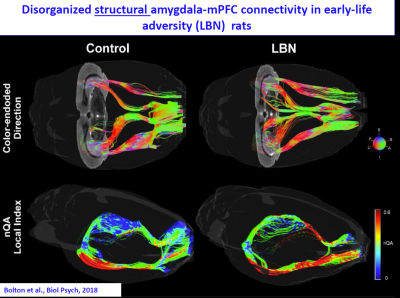Stress & the Developing Brain: Lessons from the Lab
1University of California - Irvine, Irvine, CA, United States
Synopsis
There is compelling evidence from human studies and experimental models that stress or adversity during developmental sensitive periods influences brain maturation, with major cognitive and emotional consequences. However, what exactly stress is, how the developing brain senses it, and how the 'stress-signals' act to influence brain circuit maturation has remained unclear. We will employ neurobiological principles and combined neuroimaging, molecular and behavioral approaches to address these critical questions: we need the answers in order to intervene and prevent aberrant circuit developement and function that promotes vulnerabilities to mental and cognitive disorders.
Text Abstract
Vulnerability to emotional disorders including depression
derives from interactions between genes and environment, especially during
sensitive developmental periods. Adverse early-life experiences provoke the
release and modify the expression of several stress mediators and
neurotransmitters within specific brain regions. The interaction of these
mediators with developing neurons and neuronal networks may lead to
long-lasting structural and functional alterations associated with cognitive
and emotional consequences.
Whereas a vast body of work has linked quantitative and
qualitative aspects of stress to adolescent and adult outcomes, a number of
questions are unclear. What distinguishes ‘normal’ from pathologic or toxic
stress? How are the effects of stress transformed into structural and
functional changes in individual neurons and neuronal networks? Which ones are
affected?
We review these questions in the context of established and
emerging studies. We introduce a novel concept regarding the origins of toxic early-life
stress, stating that it may derive from specific patterns of environmental
signals, especially those derived from the mother or caretaker. Fragmented and
unpredictable patterns of maternal care behaviors induce a profound chronic stress.
The aberrant patterns and rhythms of early-life sensory input might also
directly and adversely influence the maturation of cognitive and emotional
brain circuits, in analogy to visual and auditory brain systems. Thus,
unpredictable, stress-provoking early-life experiences may influence adolescent
cognitive and emotional outcomes by disrupting the maturation of the underlying
brain networks.
Comprehensive approaches and multiple levels of analysis are
required to probe the protean consequences of early-life adversity on the
developing brain. These involve integrated human and animal-model studies, and approaches
ranging from in vivo imaging to novel
neuroanatomical, molecular, epigenomic and computational methodologies. Because
early-life adversity is a powerful determinant of subsequent vulnerabilities to
emotional and cognitive pathologies, understanding the underlying processes
will have profound implications for the world’s current and future children.Acknowledgements
This work was supported by the National Institute of Health grants P50 MH096889, R01 NS028912, R01 MH073136.References
Chen Y, Baram TZ. Toward Understanding How Early-Life Stress ReprogramsCognitive and Emotional Brain Networks. Neuropsychopharmacology. 2016;41:197-206. doi: 10.1038/npp.2015.181.
Molet J, Maras PM, Kinney-Lang E, Harris NG, Rashid F, Ivy AS, Solodkin A,Obenaus A, Baram TZ. MRI uncovers disrupted hippocampal microstructure thatunderlies memory impairments after early-life adversity. Hippocampus. 2016;26:1618-1632. doi: 10.1002/hipo.22661
